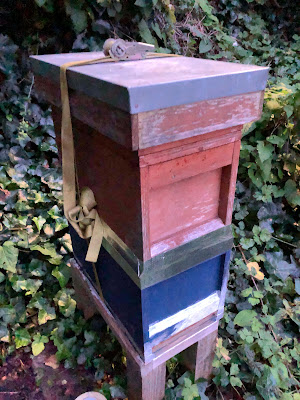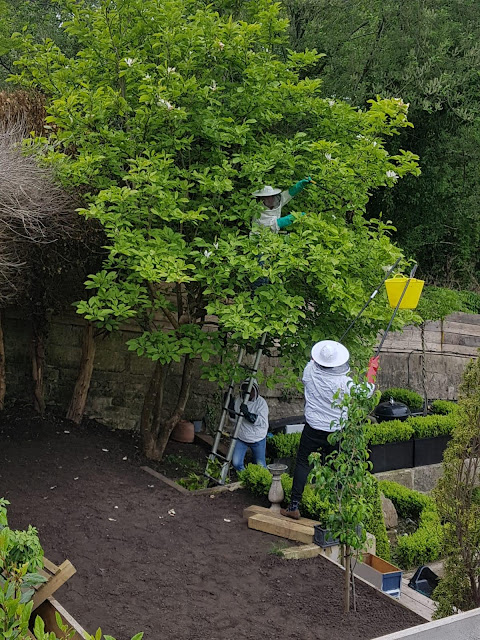I checked the bees on Saturday, and everything in the nucleus (Ottoline's bees) was fine. All good in June's hive (#2) as well.
Things in Katherine's hive also looked fine - at least, at first. There were recently-laid eggs, as well as capped and un-capped brood. A few frames in, and I found an open queen cell, which I removed. On the next frame were four more. I tackled the first three, removing the small larvae and cutting out the structure of the cells to discourage the bees from re-using them.
When I got to the 4th queen cell, I noticed something odd. Instead of the end being completely open, there was a dark shape just poking through the entrance. At first, I thought this would be a worker bee, depositing royal jelly in the cell for the larval queen to feed on. But, oddly, it didn't seem to be moving. Also, it didn't look like the end of a worker bee - it didn't seem stripy enough, and it was too pointy. I carefully cut away at the sides of the queen cell, and was amazed to pull out this:
Yep - that's Queen Katherine - dead, after being stuck head-first in a queen cell. This is a picture showing where it was located on the frame (you can clearly see it in the corner, towards the lower part of the photo):
And here's a closer look (you can even still see specks of green paint that have rubbed off from her thorax):
This is really remarkable - it's the first time I've found a dead queen inside a hive (though I have previously seen a dead queen outside, after she was dumped there by her workers). And the really weird thing is, it seemed from the shape of the cell - the entrance of which seemed too narrow for her to squeeze into - that the workers were sealing her in, from the outside. This is genuinely odd - I've never seen or heard of bees behaving like this before.
So, what had happened? Well, there are two possibilities:
- She'd for some reason crawled into the queen cell head-first, and got stuck
- The workers chased her into the cell, and killed her
Looking at option [1], it's not by any means impossible. But it is unlikely. A queen will always enter a queen cell abdomen-first, as she has only one business being there - to lay an egg. She has no reason to go in head-first if the cell is empty. And if there is already a larva in there, with royal jelly, then there's no point going in head-first either (she can't feed the larva - that's strictly a worker bee job - and she can't eat the royal jelly, as she has to be fed mouth-to-mouth by the workers). But maybe it was a freak accident?
Or maybe not. After all, she had laid eggs within the last day or so (I know - I saw them). So why was she dead? She could, perhaps, have got stuck and died - but I'm not sure there would have been enough time for her to have starved to death. Maybe, then, she had been stung to death by the workers, who for some reason had decided to replace her. If you look at the photo of her (click on it to see it in higher-resolution) you'll notice her wings have been damaged. Now, that might have happened when I was getting her out of the cell. But I suspect they may have been bitten by the workers when they attacked her.
Like inside a beehive is pretty brutal - if the workers decide the queen is not meeting their high standards, then they will cheerfully kill her off and replace her with one of their sisters. I've had this happen a couple of times before - it's just a part of beekeeping life that you get used to. But never before have I found the queen's body still inside the hive. I've been keeping bees for 10 years now, and yet every season they still manage to surprise me!
In case you're wondering how the bees will cope without a queen - don't worry. Right now, they will be making new queen cells (from the eggs I saw), and I will have a look in the hive tomorrow to see how they are getting on with raising Katherine's replacement.





























